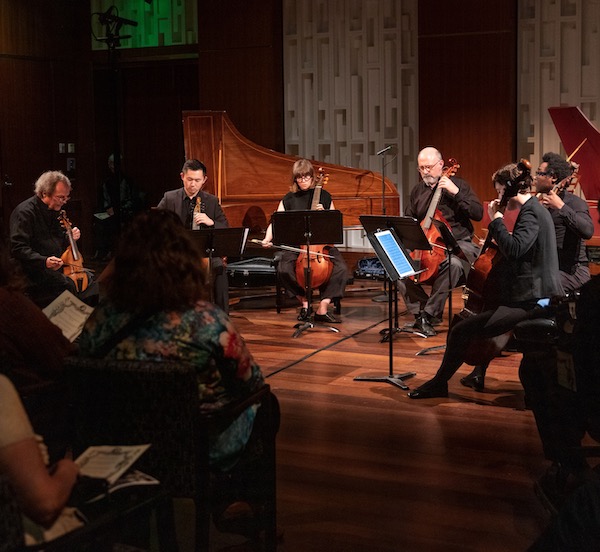Smithsonian Chamber Music Society returns to life with Bach, harpsichords and violas da gamba

The Smithsonian Chamber Players performed a Ricercar from Bach’s The Musical Offering on six violas da gamba Saturday night. Photo: Jaclyn Nash
Musical life has mostly returned to normal in Washington as the world learns to live with the coronavirus. Another sign of that recovery emerged Saturday night, when the Smithsonian Chamber Music Society gave its first live concert since 2020 in the Taubman Hall of Music at the National Museum of American History. Four Smithsonian Haydn Academy fellows, all playing violas da gamba, teamed up for an all-Bach program.
Joseph Gascho and SCMS director Kenneth Slowik joined Chelsea Bernstein, Wade Davis, Catherine Slowik (daughter of Kenneth), and Arnie Tanimoto on violas da gamba, for the six-part Ricercar Bach composed on a theme given to him by King Frederick II of Prussia. Forming part of Bach’s late contrapuntal tour de force, The Musical Offering, it is usually heard on a keyboard instrument. Bach actually wrote each of the six parts on a different staff, as if for a viol consort, with the ensemble of viols of different sizes from treble to bass.
The famous minor-mode subject of this strict fugal piece, centered on a descending chromatic scale, slithered through the fingers of all six gamba players. While a keyboard player has the advantage in coordinating all the voices with one another, each iteration of the melody was much more independent in this instrumentation. Episodes with fewer voices revealed each of the instruments; the sound of the lowest part, anchored on the bass viola da gamba, made by an anonymous craftsman in Venice around 1680 and played by Bernstein.
In keeping with the historical leaning of this eminent series, the program brought together more rarities from Bach’s oeuvre. Three of the young musicians each played one of the composer’s Sonatas for Viola da Gamba and Harpsichord, all delightful but not often heard, with Kenneth Slowik now playing one of the two harpsichords on the intimate stage.
Wade Davis seemed least comfortable of the three, in the Sonata in G Major, although there was much to appreciate in the placid opening movement, not least the sound of the 1683 bass viola da gamba, built by Joachim Tielke in Hamburg. Intonation lapses destabilized the other three movements, especially as the tessitura rose into the heights. The third movement, a gentle Andante, proved a subtle highlight, with Slowik accompanying ably on the harpsichord built by Thomas and Barbara Wolf in 1985, modeled on a Christian Vater instrument from 1738.
Chelsea Bernstein brimmed with confidence on the Sonata in D Major, the only one of the three pieces in which Bach specified the use of a seven-stringed viola da gamba, with its added low notes. The two fast movements were crisp and fleet, with beautiful delineation of the many runs, especially in the fourth movement, with athletic leaps down to the instrument’s bottom range. Slowik played with clarity, making use of the brighter timbre of the other harpsichord, built by the Wolfs a decade later on the same model.
Arnie Tanimoto had the most beautiful tone quality of the three, playing a 1708 bass viola da gamba built by Matthias Hummel in Nuremberg, on the Sonata in G Minor. Intonation troubles may have contributed to some reticence at times, enough of a concern that he attempted a quick tuning adjustment at the midpoint of the slow movement. In addition to the singing legato playing of the slow movement, Tanimoto excelled at agile passages as well, with many florid runs effortlessly laid out for the ear in the fast outer movements. The sections with extended pedal points in the third movement, churned with intensity by Slowik, heightened the drama of the sonata’s conclusion.
Josephs Gascho and Kenneth Slowik performed Bach’s Concerto for Two Harpsichords Saturday night. Photo: Jaclyn Nash
The only box unchecked in the evening was to hear both of the harpsichords together. Bach’s Concerto for Two Harpsichords provided the opportunity, with Joseph Gascho taking the first part on the 1995 Wolf harpsichord and Kenneth Slowik taking second on its earlier counterpart. The two harpsichords remained on opposite sides of the stage, a decision that allowed the ear to distinguish the antiphonal interplay of the twin instruments but seemed to make coordination challenging for the two musicians, who could not see one another easily.
Prudent use of echo effects between the two manuals on each instrument quadrupled the delightful sense of back and forth in the first movement. The two musicians’ pacing was most in synch in the lovely slow movement; elsewhere, especially in the challenging finale, the tempo fluctuated a bit.
Although there were some shaky moments, the evening offered many reasons to celebrate the return of historical music to the Smithsonian’s temple of American history.
The program will be repeated 6:30 p.m. Sunday. smithsonianassociates.org
